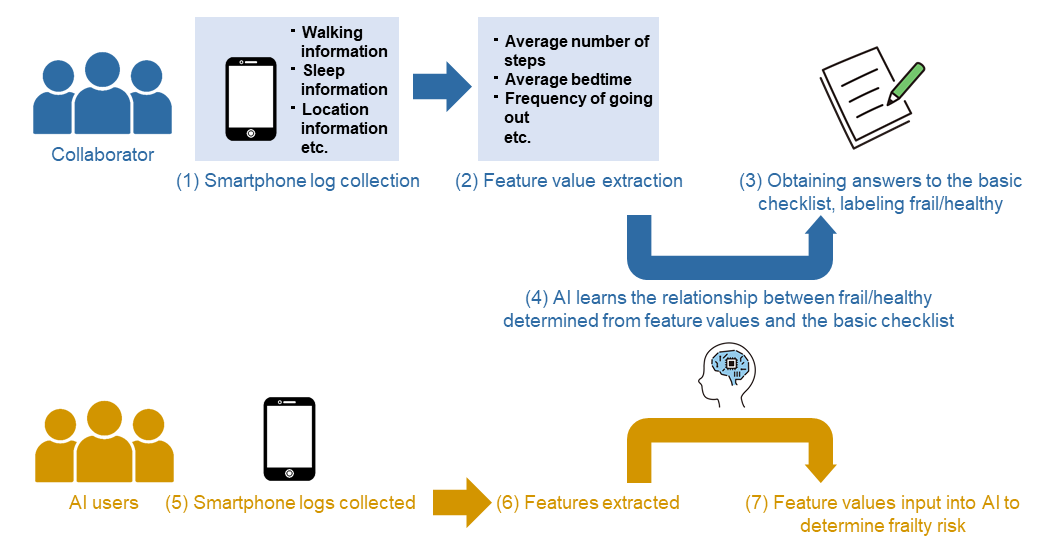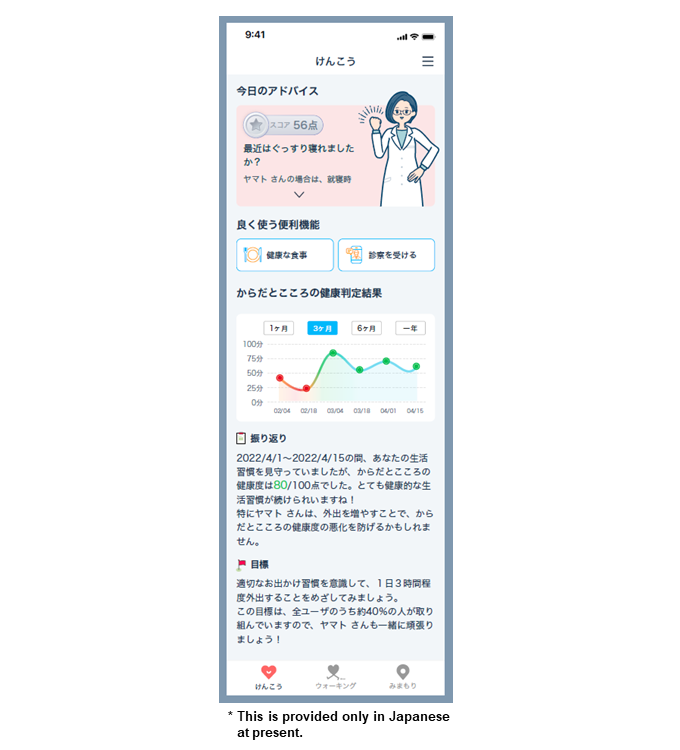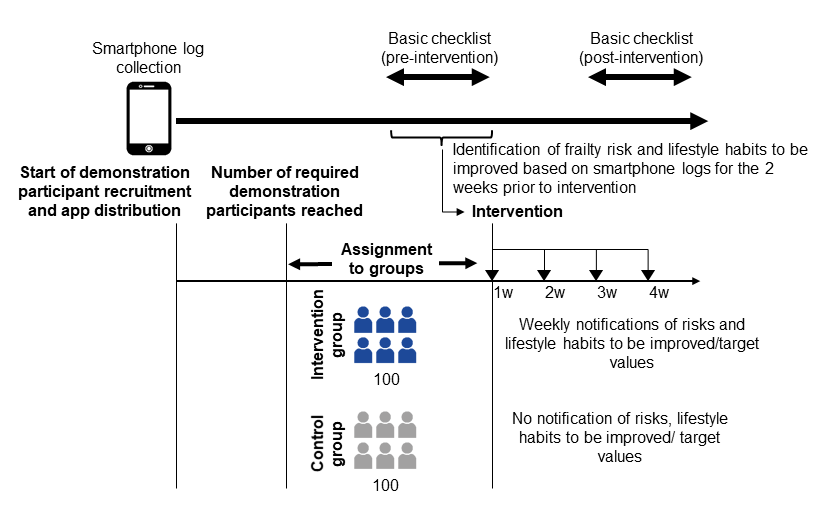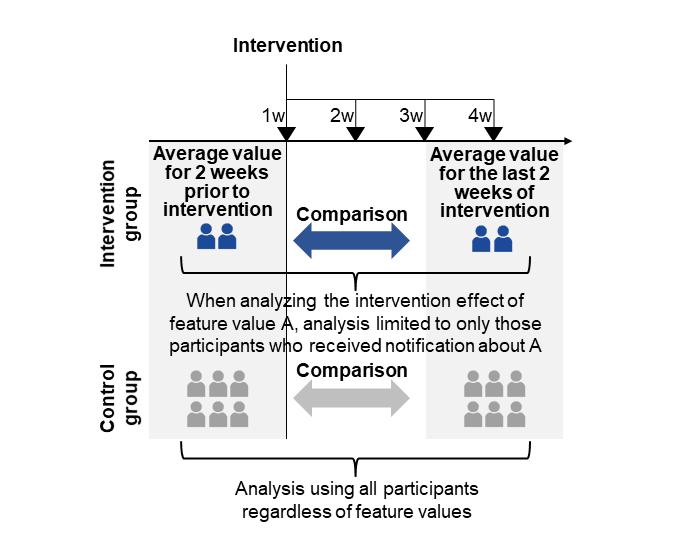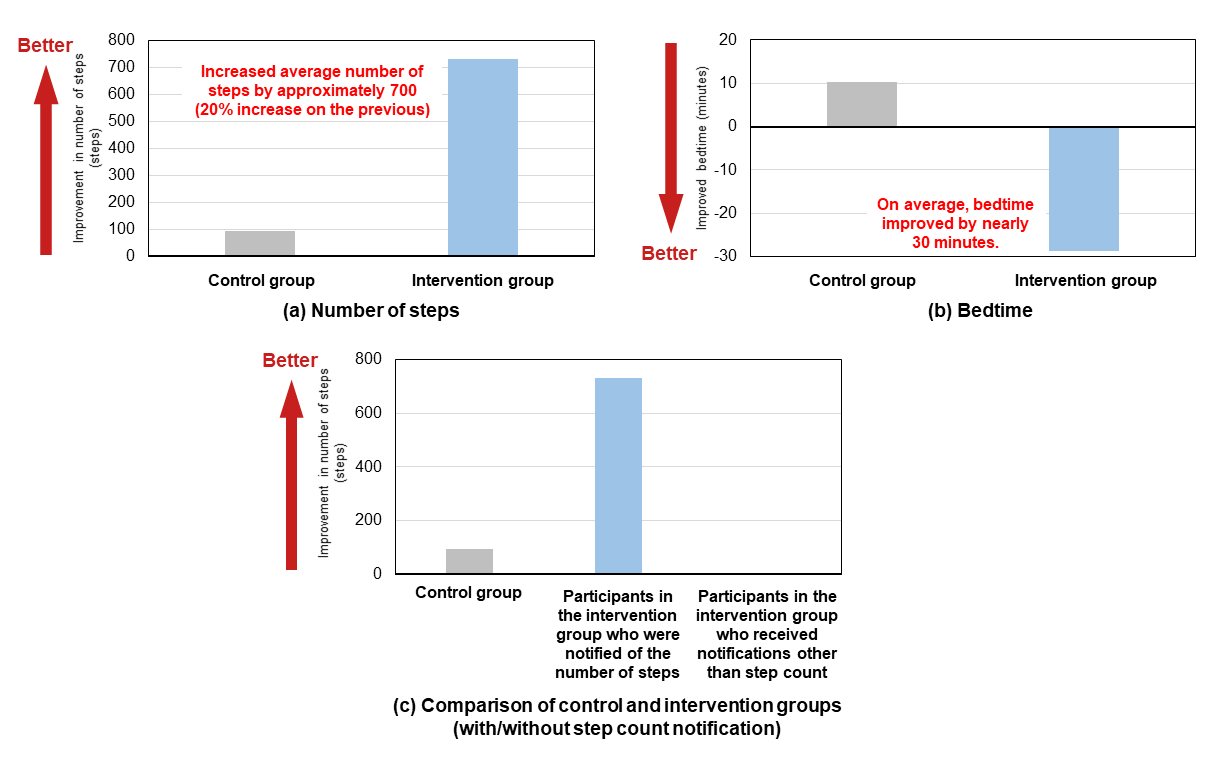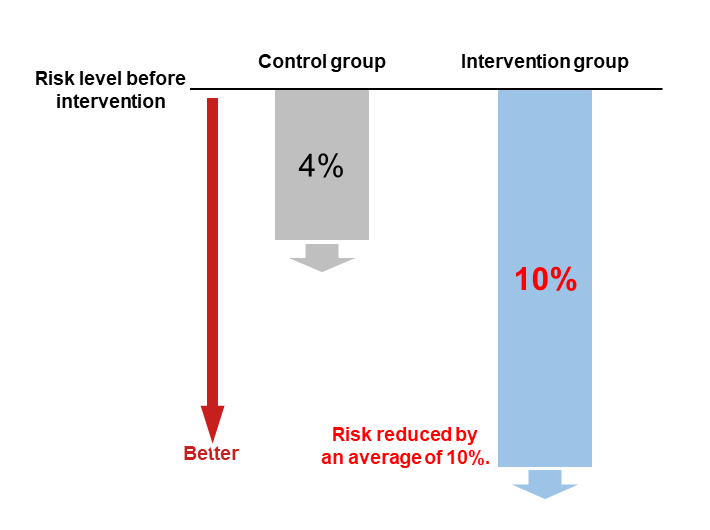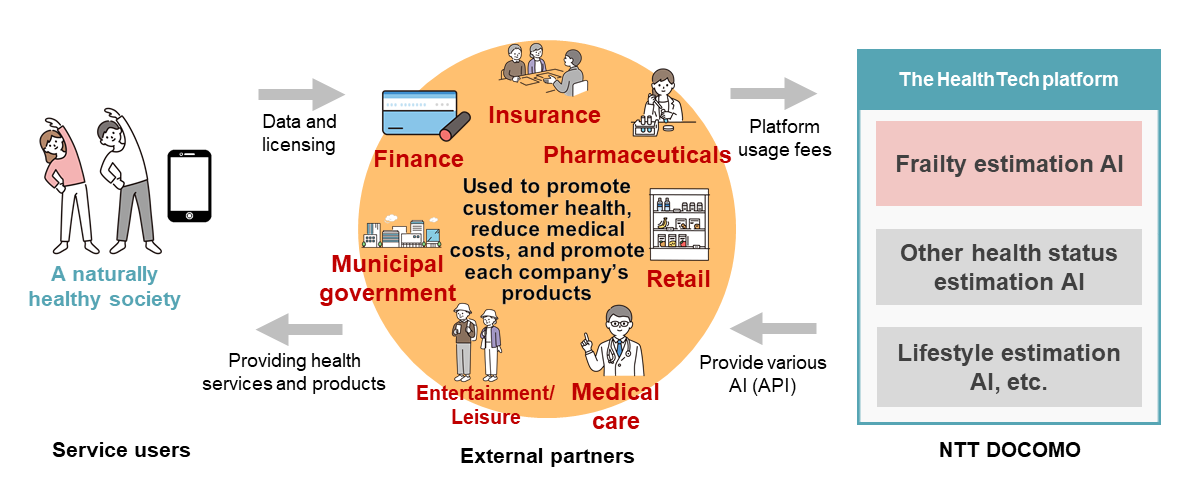Frailty Estimation AI that Uses Smartphone Logs to Reduce the Risk of Needing Aged Care
Healthcare Behavioral Modification Curbing the Cost of Aged Care
Takafumi Yamauchi, Satsuki Kumatani, Shota Kobayashi and Yuki Yamada
X-Tech Development Department
Abstract
Frailty indicates the preliminary stage of requiring aged care, in which the functions of the body and mind have weakened with age. There is a growing need for early detection and intervention from the perspective of curbing care costs, etc. However, it has been difficult to conduct a broad survey of residents using existing methods based on face-to-face diagnoses and questionnaires. To create a world where everyone can maintain and improve their health through daily life, NTT DOCOMO has developed a frailty estimation AI that uses smartphone logs that can be automatically obtained. This technology makes it possible to identify the risk of frailty with lower burdens, identify lifestyle habits that need to be improved for individuals, and lead to behavioral modification.
01. Introduction
-
NTT DOCOMO has identified medical and healthcare as one of its growth areas, ...
Open

NTT DOCOMO has identified medical and healthcare as one of its growth areas, and has been providing services such as “d-Healthcare” to raise awareness and interest in health. NTT DOCOMO is developing Artificial Intelligence (AI) to estimate people’s health status and link it to healthy behaviors, with the aim of further evolving its services and creating a society in which everyone can maintain and improve their health in daily life.
Frailty refers to a state of decline in physical and cognitive functions between the healthy state and the state requiring aged care. Of the elderly, 49.5% are reported to be frail if prefrailty*1 is included in Japan [1]. To extend people’s healthy life expectancy and curb aged care costs, which exceed JPY 10 trillion, it is important to promptly detect frailty, which is the preliminary stage of requiring aged care, and to take measures to reduce the risk of requiring aged care, such as lifestyle improvement.
Currently, however, diagnosis of frailty imposes certain burdens on those diagnosed, such as measurement of grip strength and walking speed in face-to-face examinations or responses to a 25-item questionnaire (hereafter referred to as “the basic checklist”), making it difficult to conduct extensive surveys of seniors and continuously track them [2]. To address these issues, NTT DOCOMO developed a frailty estimation AI that automatically obtains information on the user’s lifestyle and habits via smartphones after obtaining consent, estimates frailty risk from such information, and encourages behavioral modification in accordance with risk and the lifestyle of the individual, taking advantage of the touch point with customers, the smartphone, one of the company’s strengths. In Japan, smartphones are also prevalent among seniors, with 80% of those in their 60s and 62% of those in their 70s using one [3], making it possible to reach a wide range of seniors with the frailty estimation AI.
This article provides an overview of the frailty estimation AI, the results of demonstration experiments, and the implementation of the functionality in commercial services.
- Prefrailty: The state before reaching frailty, between healthy and frail.
-
2.1 AI Development Methods
Open

An overview of the frailty estimation AI is shown in Figure 1. Utilizing NTT DOCOMO’s d-point club questionnaire and other methods, we collected answers to the basic checklist and smartphone logs related to lifestyle habits, including information about walking, sleep, location information, and communication app usage, from several hundred d-point club members (hereafter referred to as “collaborators”) after obtaining their consent. Subsequently, in our own data analysis environment, we created feature values from smartphone logs, such as the average number of steps taken, that are considered to contribute to the estimation of frailty risk. Then, based on the results of the responses to the basic checklist, each collaborator was labeled as frail/healthy. Since some of the items in the basic checklist ask about lifestyle and state of mind in the last two weeks, we used smartphone logs for the previous two weeks from the basic checklist responses to get the AI to learn the relationship between the feature values and frail/healthy by using machine learning*2 methods. This enables the AI to output the individual’s risk of frailty when their smartphone log is entered.
2.2 Behavioral Modification Logic
The frailty estimation AI not only present the risk of frailty based on smartphone logs, but also suggests lifestyle habits and target values that should be improved according to the individual to encourage users to modify their behaviors.
In presenting lifestyle habits that need to be improved, Explainable AI (XAI)*3 technology is first used to identify smartphone logs that show increasing risk of frailty for each individual. Of the smartphone logs that show increasing risk, the most risk-increasing items that the individual can interpret, and accordingly modify their behavior (e.g., average number of steps taken per day and bedtime), are presented as lifestyle habits that should be improved. Although it is possible to suggest multiple lifestyle habits to be improved, the user may not be able to decide on which lifestyle habit to improve first due to the choice overload effect*4, so only the habits that increase risk the most are suggested.
It is important to provide individual, specific, and feasible goals for lifestyle improvement [4]. Therefore, the frailty estimation AI uses an individual’s smartphone logs for the past two weeks to determine the distribution of lifestyle habits that need to be improved and suggests target values that are considered moderately challenging for the individual (Figure 2).
- Machine learning: A mechanism that enables a computer to learn the relationship between inputs and outputs, through statistical processing of example data.
- XAI: Technology that provides human-interpretable reasons or rationales for AI output.
- Choice overload effect: The phenomenon of having too many choices, and making a choice itself becomes psychologically burdensome and one becomes unable to make a choice or take action.
-
3.1 Details of the Demonstration Experiment
Open

To confirm the risk estimation performance and behavioral modification effects of the frailty estimation AI, we conducted a demonstration experiment of the system on approximately 200 Tokyo workers and residents aged 50 or older (hereafter referred to as “demonstration participants”) after obtaining their consent (Figure 3). Participants in the experiment were asked to install an application dedicated to the experiment (hereinafter referred to as “the dedicated app”) on their own smartphones. Demonstration participants were randomly assigned to two groups, one an intervention group provided with the frailty estimation AI functionality on the dedicated app, and the other a control group without such functionality. Smartphone logs were collected from all demonstration participants, regardless of whether they were in the intervention or control group, through the dedicated app during the demonstration period. In addition, responses to a basic checklist were obtained at the time of participation and at the end of the demonstration.
In addition, after a smartphone log collection period of at least two weeks after participating in the demonstration experiment, the intervention group was notified by the dedicated app once a week for four weeks of their frailty risk, lifestyle habits to be improved, and target values based on the risk assessment results by the frailty estimation AI.
3.2 Analysis Method
1) Evaluation of Risk Estimation Performance of Frailty Estimation AI
To evaluate the risk estimation performance of the frailty estimation AI, we used the output of the frailty estimation AI (frailty risk) based on the input of logs for the two weeks of participation in the demonstration experiment, and a basic checklist also obtained during participation in the demonstration experiment. The proportion of the demonstration participants whose frailty risk exceeded a predetermined threshold, i.e., the frailty estimation AI judged the possibility of frailty to be high and who were also judged to have frailty in the basic checklist was defined as sensitivity*5, and the proportion of demonstration participants whose frailty risk fell below a predetermined threshold, i.e., the frailty estimation AI judged the possibility of frailty to be low and who were also judged to be healthy in the basic checklist was defined as specificity*6, and were used as evaluation indices for risk estimation performance.
2) Evaluation of Behavioral Modification Effects
To evaluate the effect of behavioral modification, we checked whether differences in lifestyle occurred in the two weeks before and after the provision of the frailty estimation AI functionality (intervention) in the intervention group. To check the influence of external factors (e.g., weather) other than the frailty estimation AI, we also analyzed changes in the lifestyle of the control group at the same time (Figure 4). For example, when checking the effect of behavioral modification in the average number of daily steps in the intervention group, the analysis was limited to the demonstration participants who were presented with the number of steps as a lifestyle habit to be improved. The control group, on the other hand, did not receive any intervention on specific lifestyle habits, so data from all demonstration participants were used for analysis.
3.3 Results of the Demonstration Experiment
1) Evaluation Results of Risk Estimation Performance
The evaluation result of risk estimation performance was 0.8 for both sensitivity and specificity, confirming that the frailty estimation AI, an unprecedented technology using only smartphone logs, has a frailty detection ability close to that of conventional frailty determination methods.
2) Evaluation Results of Behavioral Modification Effects
The evaluation results of behavioral modification effects are shown in Figure 5. For example, a significant increase in the number of steps (average of approximately 700 steps) was observed only in the intervention group. This translates to a 20% increase in steps taken compared to before the intervention. In addition, a significant behavioral modification in bedtime was observed only in the intervention group (Fig. 5(a) and (b)).
Next, to visualize the effect of presenting specific lifestyle habits and target values along with risk, we evaluated whether there was a difference in behavioral modification in the number of steps between the demonstration participants in the intervention group who were presented with number of steps as a lifestyle habit to be improved and those who were presented with other lifestyle habits. As a result, significant behavioral modification occurred only among the demonstration participants whose lifestyle habit to be improved was presented as the number of steps, confirming the significance of presenting specific lifestyle habits and target values (Fig. 5(c)).
3) Evaluation Results of Whether Frailty Risk Was Reduced
We evaluated whether the use of the frailty estimation AI reduced the risk of frailty. As shown in Figure 6, the intervention group showed an average 10% reduction in risk of frailty compared to before the intervention. A large frailty risk reduction was also observed compared to the control group, suggesting that the use of the frailty estimation AI may contribute to maintenance and promotion of health by reducing the risk of falling into a state of needing aged care. The control group also showed a reduction in the risk of frailty, but this may be due to external factors or the fact that the fixed message, “Maintain and improve your physical and mental health by reviewing your lifestyle,” was displayed to the control group, which may have caused some behavioral modification.
- Sensitivity: The proportion of events or persons correctly identified as abnormal or having a medical case (frailty in this article) among the abnormal events or persons having medical cases to be detected.
- Specificity: The proportion of events or persons correctly identified as not abnormal or having no medical case (healthy in this article) among events with no abnormalities or persons having no medical cases.
-
Due to the impact of the prolonged COVID-19 epidemic and other factors, ...
Open

Due to the impact of the prolonged COVID-19 epidemic and other factors, an increasing number of municipalities are concerned about the deterioration of the physical and cognitive functions of the elderly as they continue to live lifestyles that discourage going out and face-to-face interaction. Therefore, on September 26, 2022, NTT DOCOMO began commercial provision of the frailty estimation AI as a physical and mental health check function in its “Kenko-mileage” health promotion service for local governments [5].
NTT DOCOMO is also building the “HealthTech platform” that aggregates and incorporates various types of AI related to healthcare. The frailty estimation AI is also incorporated on this platform. By linking the HealthTech platform with Application Programming Interfaces (APIs)*7, NTT DOCOMO can easily provide the frailty estimation AI not only with its own services but also to those of its external partners, and plans to promote its deployment in various services in the future (Figure 7).
- API linkage: Linkage of different programs or software through a predefined interface.
-
This article has provided an overview of the frailty estimation AI, ...
Open

This article has provided an overview of the frailty estimation AI, the results of demonstration experiments, and the implementation of the functionality in commercial services. In the future, we plan to accumulate further evidence on the frailty estimation AI by evaluating the effects of long-term use of it on reducing aged care costs.
-
REFERENCES
Open

- [1] Tokyo Metropolitan Institute of Gerontology: <Press Release> “Frailty Ratio of the Entire Elderly Japanese Population is 8.7%,” Sep. 2020 (in Japanese).
 https://www.tmghig.jp/research/release/2020/0903.html
https://www.tmghig.jp/research/release/2020/0903.html - [2] H. Arai (ed.): “Clinical Guide for Frailty (2018 Edition),” Life Sciences Corporation, Mar. 2018 (in Japanese).
- [3] Mobile Society Research Institute: “Smartphone ownership among seniors increases at a faster pace, exceeding 80% of seniors in their 60s and 60% of seniors in their 70s,” May 2021 (in Japanese).
- [4] Y. Fukuda (ed.): “Theory at a Glance: A Guide for Health Promotion Practice (Second Edition) (Japanese Version),” National Institute of Public Health, Mar. 2008.
- [5] NTT DOCOMO press release: “Health Support and Monitoring Functions Added to Kenko-mileage, a Resident Health Promotion Service for Municipalities,” Sep. 2022 (in Japanese).
https://www.docomo.ne.jp/info/news_release/2022/09/26_02.html
- [1] Tokyo Metropolitan Institute of Gerontology: <Press Release> “Frailty Ratio of the Entire Elderly Japanese Population is 8.7%,” Sep. 2020 (in Japanese).

